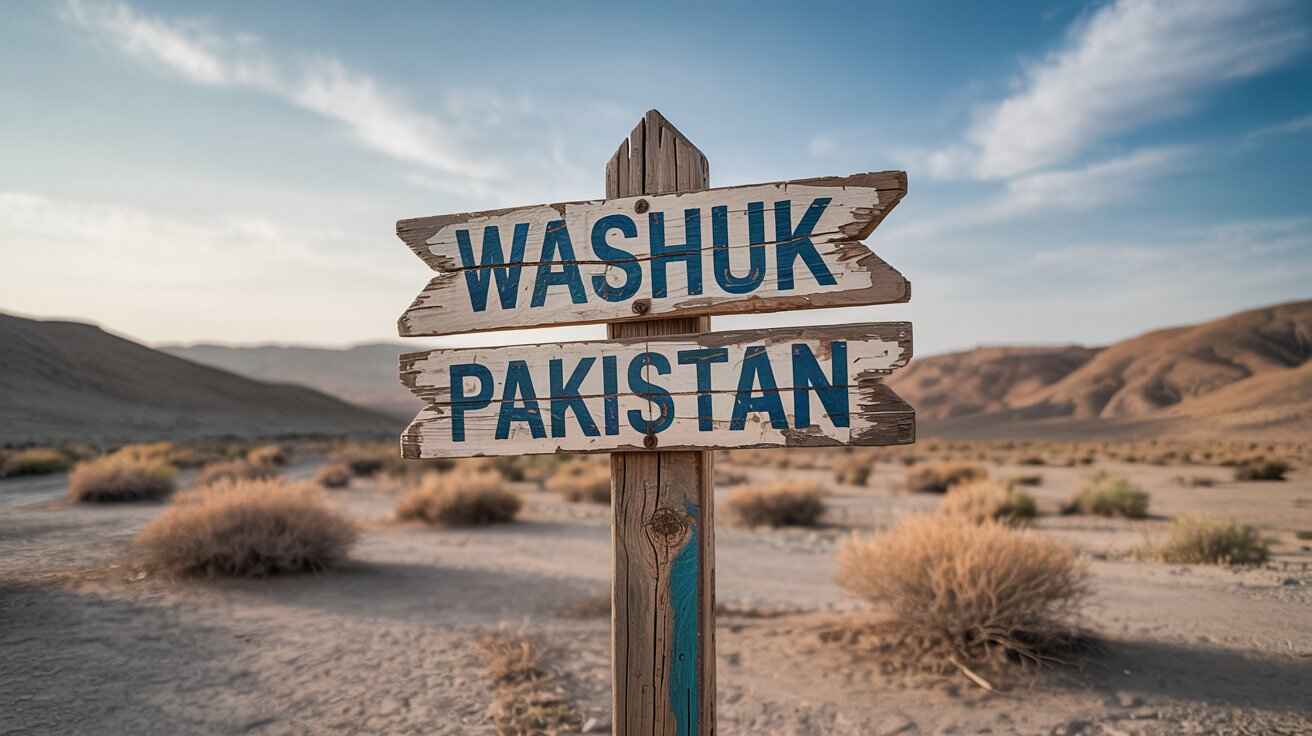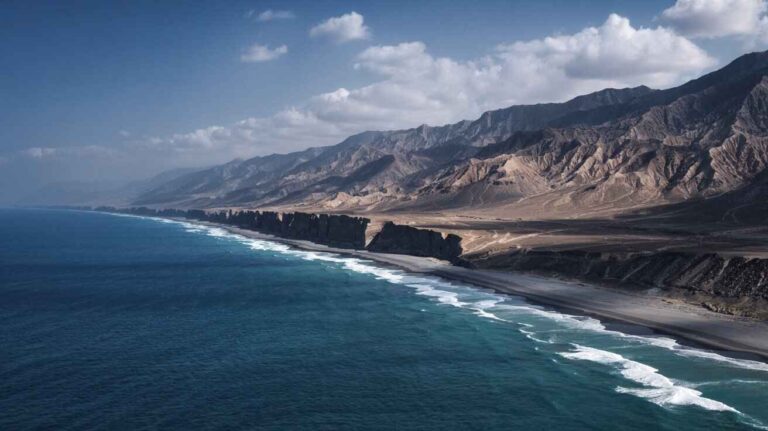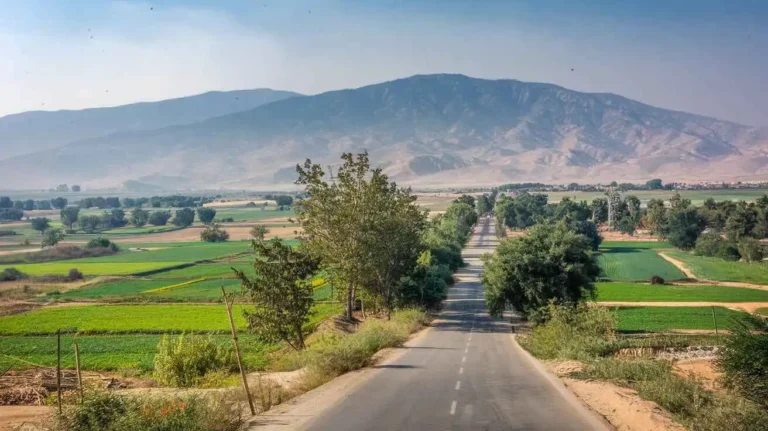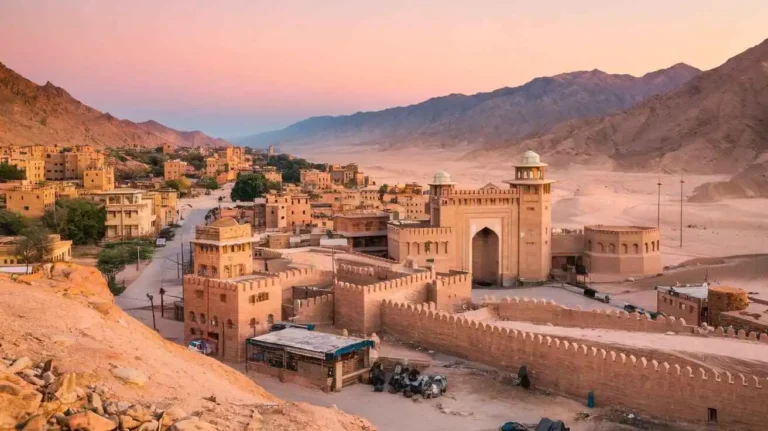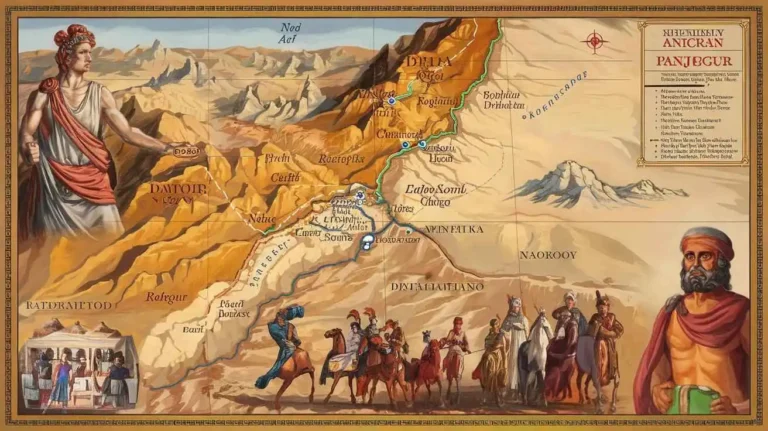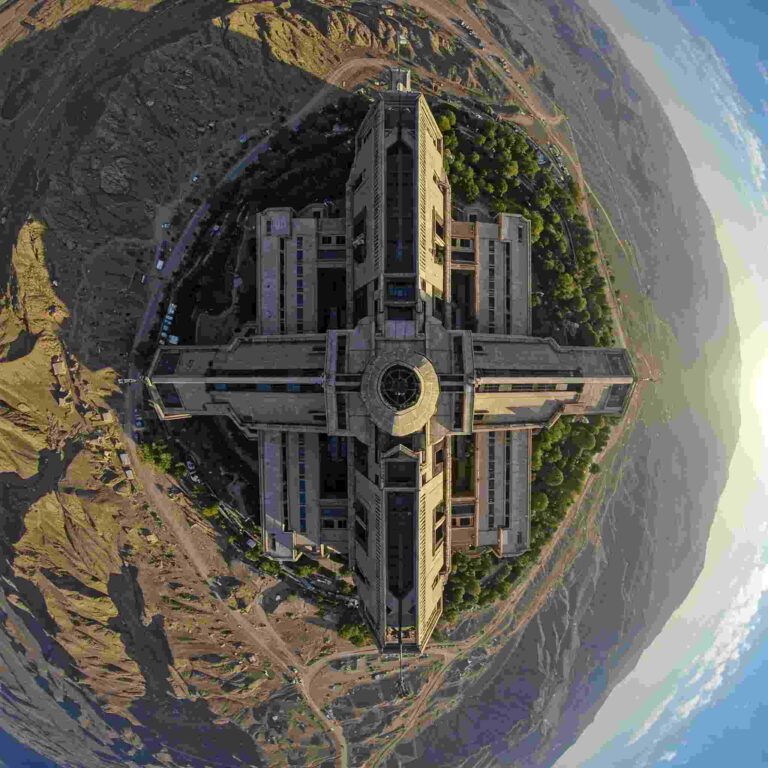Washuk: Landscape and Legacy
Washuk Balochistan
Washuk is a district situated in the southwestern part of Balochistan, Pakistan. It shares boundaries with Panjgur, Khuzdar, and Chagai districts, as well as the neighboring country Iran. The district lies between 26° 04′ 25.5″ and 28° 39′ 57.5″ north latitudes, and 62° 48′ 28″ to 65° 58′ 35″ east longitudes, marking its precise geographical coordinates. Its location places Washuk in a region of great strategic importance, both in terms of natural resources and its proximity to neighboring countries, offering a bridge between Iran and the rest of Balochistan.
The district of Washuk is home to a diverse set of communities and landscapes, combining a unique blend of mountains, deserts, and rivers. Geographically, it lies in the southwest of Balochistan, bordered by Kharan to the north and Makran to the south. To the east, the vast desert stretches, making it a region rich in both natural resources and ecological diversity. Despite its location in a relatively arid zone, the region’s economic activities are largely based on agriculture, livestock breeding, and mining, all of which are shaped by its varied topography and climate conditions.
The district’s administrative and regional importance cannot be overstated. As an important part of Balochistan, Washuk serves as a key area for regional development with projects aimed at improving infrastructure, increasing access to electricity, and enhancing local economic activities.
The boundary with Iran has made this district a crucial site for both trade and cultural exchange, adding to the regional significance. Moreover, the proximity to key Balochistan cities such as Quetta, Panjgur, and Khuzdar contributes to its connectivity within the province. This location has also made Washuk a potential hub for cross-border commerce, especially in terms of agriculture and mineral resources.
Washuk District at a Glance
Washuk District is home to over 176,206 persons, spread across a vast area of approximately 33,093 km². This means that Washuk has a population density of just 4.8 persons per km², reflecting the large open spaces and desert-like conditions of the region. The district is home to three key Tehsils: Mashkhel, Basima, and Washuk Tehsil, each contributing to the district’s diverse culture and local economy.
In terms of agriculture, Washuk is renowned for producing a variety of crops. The region is heavily reliant on subsistence farming, which includes crops like wheat, barley, maize, and cotton. The area’s economy also benefits from livestock breeding, which remains one of the largest contributors to the district’s economy. Animal husbandry plays a vital role, with cattle, buffaloes, sheep, and goats among the most commonly raised animals in the area. Additionally, fishing, hunting, and community-based services also make up a substantial portion of the economic structure.
In terms of infrastructure, Washuk has about 1,131 km of black-topped roads and 1,326 km of shingle roads, which connect the major towns within the district, though road quality varies greatly across different regions. There is also an emphasis on providing access to electricity, with much of it coming from Quetta Electricity Supply Corporation (QESCO), alongside other resources like water and gas.

Topography of Washuk District
The topography of Washuk is defined by its mountainous landscapes and desert plains. The district is home to the famous Siahan Range and the Rakhshan Valley, both of which are landmarks in the southern part of the district. Siahan Range, part of the larger Makran mountain system, runs across Washuk’s western side, creating ridges and hills that are vital for agriculture and local water collection. These hills are often prone to heavy rains, causing hill torrents to flood the low-lying areas and spread stones, pebbles, and debris across the land.
On the eastern side of Washuk, the land becomes more arid with vast desert areas extending towards Iran. The Hamun-i-Mashkel, located along the border with Iran, is the largest desert lake in Pakistan, though it is seasonal and tends to dry out during the summer months. Its dry lake bed is often sun-cracked, while shifting sand dunes dominate the landscape. These dunes are a significant feature of the northern and central parts of Washuk, where the Registan Desert lies. The wind-borne sand shapes the landscape into beautiful crescent-shaped dunes that make the region both a geographic and cultural marvel.
The Garr Hills to the west and Boddo River in the east mark the other physical boundaries of Washuk. Nawars, small streams, and shifting sand dunes further add to the geographical complexity, making Washuk a diverse and ecologically rich region.
Rivers, Streams, and Lakes
The Rivers and streams of Washuk are primarily seasonal. The River Rakhshan, which originates from the Siahan Range, runs southwestward through the district, providing essential water for agriculture. Other small streams include Lop Stream, which runs towards the Nag-e-Kalat and provides some irrigation for the surrounding areas. The Hamun-e-Mashkel, a seasonal lake, is perhaps the most significant body of water in Washuk. It acts as a desert lake that often experiences dry periods but provides a vital water source when it is filled.
Despite the scarcity of permanent water in some parts of Washuk, seasonal hill torrents and smaller streams continue to play a vital role in the livelihood of the district’s people. These water sources often accumulate during the monsoon season and provide a much-needed respite in an otherwise dry landscape.
Forests of Washuk District
Washuk is not only home to deserts and mountains but also contains a rich diversity of xerophytic plants in its desert forests. These forests are mainly composed of olive and pistachio trees, along with other desert-adapted species like haloxylon, gugal, and camel thorn. These plants have evolved to thrive in dry conditions and form the backbone of the local ecosystem. The region’s forests support wildlife and provide resources like firewood, fodder, and medicinal plants.
Some of the most notable trees include the black saxaul and pistacia khinjjuk, which are hardy and resilient in this harsh environment. These forests, though sparse, play a crucial role in stabilizing the soil and preventing desertification in some parts of the district.
Soils of Washuk District
The soil of Washuk is predominantly alluvial and fertile, especially along the river valleys and near the foothills. These soils are ideal for agriculture, particularly for growing crops like wheat, barley, and vegetables. However, much of the district’s land is also covered with dry, moisture-limited soils that are less conducive to farming, particularly in the desert regions. Farmers in the area depend on the availability of water through traditional irrigation methods like wells and tube wells, especially for rainfed crops.
Economic Activity in Washuk
Washuk’s economic landscape is a combination of traditional activities and modern industries. Agriculture forms the backbone of the district’s economy, with livestock breeding, farming, and fishing being the main contributors. The region is known for producing crops such as wheat, barley, and maize, along with various fruits like dates, grapes, and pomegranates. Livestock breeding has also been a key economic activity, with camels, goats, and cattle being raised for both local consumption and trade.
Additionally, Washuk has seen a rise in the development of small-scale industries and manufacturing, with local craftsmanship like embroidery, leather sandal making, and clothing production gaining popularity. Poultry farming and bee-keeping are also emerging economic activities, contributing to the region’s growth. The construction sector is also a significant part of the local economy, with ongoing infrastructure projects aimed at improving roads, communication, and electricity supply.
The district’s economic infrastructure is centered around electricity, water, and transportation, with roads and communication networks gradually improving. However, challenges like limited access to clean water and electricity remain in many rural parts of the district.
Land Use and Agriculture in Washuk
The land use in Washuk is a mixture of cultivated areas and uncultivated land. According to Balochistan Development Statistics, over 105,988 hectares are cultivated, with wheat, barley, and other subsistence crops forming the bulk of the produce. Fruits like apricots, grapes, and pomegranates are also significant agricultural outputs of the region.
Minerals and Mining in Washuk
Washuk is also home to a variety of minerals, with significant deposits found across the district. The mineral resources of Washuk contribute to the region’s economy, particularly in the mining of limestone, gypsum, marble, and granite. The mining sector is gradually developing, with small-scale operations focusing on extracting these minerals for local use and regional trade. These minerals are essential for the construction and manufacturing industries, and they provide a foundation for future economic development in the district.
One of the major mineral-rich areas in Washuk is the Siahan Range, which is known for its rich deposits of marble. The masonry industry is growing as more marble is mined and processed for construction and decorative uses. There are also coal deposits found in certain parts of the district, although the mining of coal remains at a limited scale due to technological and financial constraints.
The mineral resources in Washuk are largely untapped, and the district holds great potential for the expansion of mining operations. If developed further, mining could become a central part of Washuk’s economy, contributing to employment opportunities and infrastructure development.
Industry and Manufacturing in Washuk
Though still in its early stages, industry and manufacturing are gradually taking root in Washuk. The district has immense potential for industrial growth due to its rich natural resources and proximity to major trade routes. The local textile and handicraft industries are beginning to see expansion, with embroidery and traditional fabric production emerging as key components of the local economy.
In recent years, there has been an increase in small-scale industries such as food processing units, construction material production, and metalworks. These industries primarily serve the local market but are slowly gaining recognition in neighboring regions. The availability of local resources, including minerals, agricultural products, and livestock, positions Washuk as a viable area for establishing more manufacturing operations, such as brick production, construction materials, and consumer goods.
Moreover, the manufacturing sector could benefit from the growing regional demand for construction materials due to infrastructure development projects in Balochistan. This could further stimulate job creation and contribute to economic stability in the district.
Postal Services in Washuk
Though relatively underdeveloped compared to urban areas, postal services in Washuk are critical for facilitating communication and trade within the district and beyond. The district has a network of post offices that handle the delivery of letters, parcels, and important documents. The Postal Service is an essential part of life in the more remote areas of Washuk, where telecommunication networks are sparse, and road access can be challenging.
In addition to traditional postal services, the local post offices also serve as hubs for financial services such as money orders and savings accounts. These services provide an important safety net for communities that may not have access to modern banking facilities. The district’s postal network plays a key role in connecting local businesses with regional markets and supporting the communication infrastructure necessary for trade and commerce to thrive.
The growing need for efficient postal services in Washuk could drive the expansion of delivery options, providing faster and more reliable access to the broader world. Additionally, the integration of digital postal services could help improve communication between Washuk and other parts of Balochistan, and even extend to international trade partners like Iran.
Rail and Airways in Washuk
The transportation network in Washuk is a vital element in connecting the district to the larger Balochistan province and beyond. Rail and airways are integral to the movement of people and goods, although both sectors are still developing. The railway system in Balochistan is primarily based in larger cities like Quetta, but there is potential to extend the rail network further into Washuk, which could enhance regional connectivity and promote economic activity.
Currently, road transport remains the dominant mode of travel and transportation within Washuk, but there are plans to improve rail connectivity with neighboring regions, particularly in terms of linking Washuk with the rest of Balochistan and Iran. A well-established rail network could play a crucial role in industrial development, tourism, and trade by facilitating the movement of goods and raw materials from Washuk’s mineral-rich areas to regional markets.
As for airways, the nearest airport for air travel from Washuk is located in Quetta. Although Washuk does not have its own commercial airport, improving road connectivity to Quetta would enable residents to access the broader aviation network. Air travel could become a critical part of Washuk’s future, particularly for businesses, tourists, and trade-related activities, facilitating the region’s economic integration with international markets.
Washuk is a rural town located in the southwest of Balochistan, Pakistan. It serves as the headquarters of Washuk District and holds a significant place in the geographic and economic framework of the region. The district is located about 300 kilometers from Quetta, the provincial capital, and is bordered by Chaghi to the north, Kharan to the east, and Panjgur to the south. To the west, the district shares a boundary with Iran. Historically, Washuk was bifurcated into two distinct areas: A and B, each with its unique characteristics, but both contributing equally to the local governance and administration.
The population of Washuk district was recorded at 176,206 in the 2017 census, with a male-to-female ratio of approximately 52.23% to 47.77%. The district is primarily rural, with 87.59% of the population residing in villages and remote areas. Urbanization is still developing, but the district faces challenges such as poverty, poor access to basic services, and the lack of infrastructure in some parts. This rural setup, however, does not diminish the importance of Washuk district in Balochistan’s agricultural landscape, where wheat, barley, lentils, and cumin are grown on the fertile lands supported by wells, tube wells, and irrigation systems.
Banking and Financial Services
The financial infrastructure in Washuk is still under development. There are a few banking and financial institutions serving the population, including a National Bank with branches offering basic services. There are only three branches in the district, which limits access to broader financial services such as loans, savings, and investments for the local population. However, the presence of these banks has provided some support to local businesses and entrepreneurs seeking to engage in agricultural or small-scale enterprises. Financial institutions, such as Bank Ltd., are slowly expanding their reach to offer more specialized services, which may prove beneficial for the district’s growth.
Electricity and Gas Supply
In terms of utilities, electricity and gas are provided to the district by the Quetta Electric Supply Company (QESCO), which is responsible for the transmission and supply of electricity. Despite the supply reaching most of the population, there are frequent power outages, especially in the more remote areas, which hamper economic and educational activities. Gas is also available but in limited quantities, with many areas relying on alternative energy sources such as solar power and kerosene for lighting and cooking purposes. While the energy situation in Washuk district is improving, infrastructure development in this sector remains a work in progress.
Educational Institutions
Educational institutions in Washuk district play a crucial role in shaping the future of the local youth. The district is home to a range of primary, middle, and secondary schools, with a mix of government and private institutions. There are boys’ schools, girls’ schools, and co-education institutions serving the local population. Higher education is also gaining momentum, with the establishment of a few degree colleges and vocational training centers aimed at empowering the youth with skills that could help them gain employment. However, there is still a considerable gap in terms of the availability of universities or specialized institutes for higher learning. The gross enrolment ratio for girls in primary education is improving, but challenges like teacher shortages and lack of infrastructure hinder overall progress.
Healthcare Facilities
The healthcare system in Washuk district is still in the early stages of development. The district lacks teaching hospitals and large medical facilities, which makes it dependent on smaller rural health centers (RHCs), dispensaries, and clinics for basic health services. Mother and child healthcare is an area of concern, though efforts are being made to improve prenatal and postnatal care through various health programs. The district is also combating diseases like malaria, tuberculosis (TB), and gastrointestinal infections through the Expanded Program on Immunization (EPI) and other government health initiatives. However, access to healthcare remains limited, especially in remote and tribal areas. In the absence of specialized hospitals, many people rely on private clinics for medical care, but the cost of private healthcare is often unaffordable for the local population.
Policing and Law Enforcement
Policing in Washuk district is structured under the jurisdiction of the Deputy Commissioner (DC), supported by assistant commissioners, tehsildars, and a team of levies and police officers. The district has been historically influenced by tribal and clan lines, with law enforcement often operating in a manner that respects local traditions while maintaining order. The Washuk district is divided into two main areas, A and B, each with its respective police stations and jurisdiction. The police force consists of sepoys, hawaldars, dafeedars, and risaldars, who carry out day-to-day tasks, maintaining law and order in local towns and on highways.
There are a total of two police stations in Washuk, with jurisdiction over an area extending about 8 kilometers. The Regional Police Officer (RPO) from Kalat oversees the law enforcement activities, while the Sub-Divisional Police Officer (SDPO) and other officers coordinate efforts to ensure law and order. Although the region has been historically governed under British rule with tribal influences, modern policing systems have slowly adapted to the changing landscape. Weapons and task forces are also deployed when required to handle special law enforcement issues, including combating organized crime and tribal conflicts.
Environment and Biodiversity
The environment in Washuk district is quite diverse, with the region characterized by desert landscapes, sand dunes, and stream beds that provide a unique habitat for various species of flora and fauna. Environmental pollution remains minimal, as industrial activity in the district is negligible. However, traffic and the increasing movement of people in certain towns do contribute to some levels of local pollution. The surrounding natural resources and habitats are largely untouched, making Washuk an important site for biodiversity conservation.
Vegetation in the region varies depending on altitude, with xerophytic and non-xerophytic plants being common in the foothills and steep slopes. Gawan, Mastix, Pistacia, and khinjuk are some of the native species of flora, while Tamarix and Haloxylon are more typical of the desert areas. The district is also home to several species of mammals like the desert fox, Asiatic jackal, and the goitered gazelle, as well as migratory and local birds such as houbara bustard, see-see partridge, and various species of sparrows and finches.
Flora and Fauna
The flora in Washuk district is diverse, with plants such as ghaz, farash, athel, and broom commonly found in the arid zones. These plants are adapted to survive in the dry conditions of the region. The fauna is equally diverse, with species like the Sindh ibex, wild sheep, and the Afghan hedgehog found in the district. The Avifauna includes migratory birds and waterfowl, particularly around seasonal wetlands. Reptiles like the Indian monitor and Caspian lizard are also present in the district’s desert regions. The district’s biodiversity is crucial to the local ecosystem and plays an essential role in supporting the rural livelihoods of local communities.
Protected Areas and Wildlife
Washuk district is home to several protected areas and wildlife sanctuaries. Raghai and Rakhshan Forest are important protected zones that serve as refuges for migratory birds, deer, and gazelles. The district is also home to the Hamun-i-Mashkel wetlands, which offer a sanctuary for various species of waterfowl. The conservation of these wildlife areas is vital for maintaining the biodiversity of the district, especially considering the threats posed by climate change and human activities such as illegal hunting and deforestation.
Washuk District, nestled in Balochistan, Pakistan, is a region with a rich history, culture, and geography. This district, with its headquarters situated in the town of Washuk, holds significance within the larger province of Balochistan, which is known for its vast deserts, rugged mountains, and diverse population. The area is often recognized as an important part of Baloch history and culture, as well as its administration. Despite its remote location, Washuk’s central position in Balochistan gives it an important role in the governance and administration of the region.
Though Washuk only gained its district status in 2007, the district has long had a presence in the historical and cultural landscape of the region. The area is an excellent example of how modern governance intersects with traditional tribal customs. This article will delve deeper into Washuk’s history, administration, geography, and demographics, offering a detailed understanding of this unique district.
Washuk’s Governance and Administration
Washuk District is subdivided into three main Tehsils—Besima, Mashkel, and Washuk—each contributing to the district’s overall structure and function. The Tehsils are further broken down into Union Councils, which are responsible for local governance. In total, the district consists of 10 Union Councils, and within these, there are 216 mauzas (villages).
The district’s administration operates under a structure where each Tehsil has its own headquarters and is tasked with providing essential public services, including education, healthcare, and infrastructure. Over time, the administration has evolved to meet the needs of an increasingly diverse population.
Interestingly, Washuk, a district that has long been associated with agricultural activity, also faces challenges related to development and public services. The government’s role in balancing traditional governance with modern infrastructure is crucial for the development of the region.
Geography: Washuk’s Natural Beauty and Challenges
Washuk District spans an area of approximately 33,093 km², with vast stretches of barren desert and rugged mountains that form the backdrop of the district. A significant portion of the land is unarable, but arable land exists in scattered pockets, particularly in the fertile regions surrounding the Central Makran Range. This range, known for its towering peaks and scenic beauty, has also been a geographical feature that has shaped the culture and lifestyle of its inhabitants.
The terrain of Washuk presents both opportunities and challenges. The barren desert areas, while harsh, have formed the backdrop for numerous historical events, such as the famous migrations of the Baloch tribes. Despite these challenges, Washuk has its share of fertile land that supports farming and agriculture, providing the region with vital resources for sustenance and trade.
Another significant feature of the district’s geography is its water resources. Ancient dams, often referred to as Zoroastrian dams, are scattered throughout the region. These dams, part of the old Gabarband system, were once used to contain rainwater for agricultural purposes. They are a testament to the region’s ancient history, particularly the Zoroastrian influence that has shaped the district over millennia. The Gabarband system was built to manage water supply in the arid environment of Balochistan and remains a symbol of the ingenuity of the ancient engineers who developed it.
Demographics: A Diverse Population
The demographics of Washuk have evolved significantly over the years. According to the 2023 census, the district’s population has reached 302,623 people, showing a significant increase from previous years. The population is a mix of Balochi and Brahui speakers, with Balochi being the most widely spoken language. Around 68.29% of the population speaks Balochi, while 31.47% speaks Brahui.
The rise in population reflects the district’s growing importance as a regional hub, although the population density remains low due to the large, sparsely populated areas of barren land. Urbanization is another key demographic trend. Although still relatively small, the urban areas are growing steadily. Washuk Town, the district headquarters, is the main urban center, housing a substantial portion of the population. The urbanization of Washuk is reflected in its changing infrastructure and the development of new markets and public services. As the population grows, the district has seen a boom in its local economy with people flocking to the urban center in search of work and better living conditions.
However, the district also faces challenges regarding literacy rates and access to education. With a literacy rate of 21.58% among women and 26.76% among men, Washuk still lags behind many other regions in terms of educational access and quality.
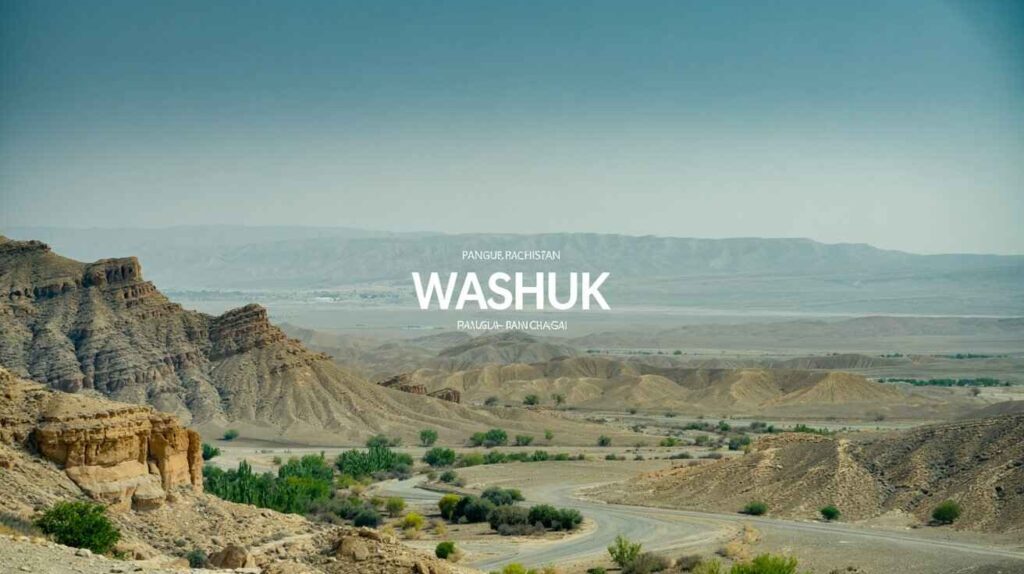
Religion and Culture: A Blend of Traditions
Washuk is predominantly a Muslim region, with the majority of the population adhering to Islam. However, religious minorities, including Christians, make up a small percentage of the population, contributing to the district’s diverse cultural fabric. The religious landscape of Washuk is shaped by a blend of Sunni Islam and local Baloch customs, creating a unique synthesis of faith and culture. Islamic traditions play a prominent role in the social and religious lives of the inhabitants, with mosques and prayer spaces scattered across the district, especially in the urban areas. Islamic festivals such as Eid al-Fitr and Eid al-Adha are celebrated with great enthusiasm and are significant events in the social calendar of Washuk.
In addition to the religion, the district’s Balochi heritage plays a significant role in shaping the cultural identity of its people. Balochi music, dance, and crafts are integral parts of the district’s social life. Balochi songs, often passed down through generations, continue to play a crucial role in preserving the language and the traditions of the area. The Balochi dress, often hand-stitched and colorful, represents an important part of the district’s cultural identity, especially during festivals and gatherings.
Balochi traditional dance, known as Attan, is still performed during weddings and public celebrations, making it one of the most visually striking and culturally important traditions in the region. Moreover, Balochi cuisine, with its rich spices and flavors, continues to be an integral part of the daily life of Washuk‘s people.
The Role of Language in Washuk
The linguistic diversity in Washuk is an essential aspect of its identity. While Balochi is the predominant language, Brahui is also widely spoken, particularly in the northern parts of the district. There are also pockets of Pashto and Urdu speakers. Balochi, a language with deep roots in the Indo-European family, has several dialects, including Makrani and Rakhshani, spoken in different parts of the district.
Interestingly, Balochi is not only a spoken language in Washuk but also a written one. Balochi has its own script, derived from the Persian alphabet, and there is a growing effort to preserve and standardize the language. Uppsala University, known for its work on Balochi, has contributed significantly to the academic study of the language. Efforts to preserve Balochi culture and language continue through local initiatives, including the work of the Balochi Academy Sarbaz, which is focused on the promotion of the language and its phonetics and syntax.
In recent years, Balochi literature has also seen a resurgence, with a growing number of writers contributing to both modern and classical genres, drawing attention to the rich traditions of storytelling and poetry that have been central to Balochi culture for centuries.
Education: Challenges and Opportunities
Despite the district’s rapid population growth, education remains an area in need of improvement. According to Alif Ailaan Pakistan District Education Rankings, Washuk ranked 131st out of 146 districts in terms of education quality and infrastructure in 2014. While there have been improvements in the literacy rates and the availability of educational facilities, the region still faces challenges, especially in rural areas where access to schools is limited.
In recent years, there has been a significant push to improve educational standards and expand facilities in Washuk. The introduction of mobile schools, adult education programs, and better-trained teachers has started to make a difference. Despite these efforts, Washuk remains one of the more underdeveloped districts when it comes to educational opportunities, particularly for women and girls.
Historical and Cultural Sites in Washuk
One of the key attractions of Washuk District is its wealth of historical and heritage sites. The Raskoh hills are home to some of the most famous domed mausoleums and gumbals (domed tombs), which are said to be the resting places of important figures from the region’s history. These mausoleums, such as Malik Dinar’s tomb, are popular for both their historical significance and their architectural beauty.
The Zoroastrian dams—part of the ancient Gabarband system—are another cultural highlight. These dams, designed to trap rainwater, were an essential part of the agricultural economy in ancient Balochistan. These structures, located in the Siahan Ranges, are not only historical but also serve as a testament to the ingenuity of the Balochi ancestors in managing water resources in a desert environment.
Washuk’s Future Prospects
Looking ahead, Washuk District holds great potential. With its significant natural resources, including fertile land and a strategic location in Balochistan, there is hope for further economic development. The district’s infrastructure is improving, and efforts to modernize agriculture and increase literacy rates are ongoing. Moreover, Washuk has an opportunity to leverage its cultural heritage to promote tourism.
However, the district faces challenges, including the need for more investment in education and the ongoing effects of geographical isolation. Nevertheless, with the right policies and continued attention to its unique resources, Washuk can emerge as an important district in the region.
The History of Washuk District, Balochistan
Washuk, now a district of Balochistan, has a history that intertwines with the history of Kharan. It was a Tehsil of Kharan until 2005 when it was upgraded to a district. This region’s early history is synonymous with Kharan, and the Balochistan District Gazetteer Series Kharan 1907 offers insight into its development.
The Origins of Washuk’s Name
According to historical accounts, the name “Washuk” is thought to have derived from Wab Shut or Khwab Shud, which translates to “he slept.” The story behind this is fascinating. Malik Dinar, a Syed and the founder of Washuk, was journeying from Bampur and could not sleep until he stopped at what is now Washuk. This desert area was where he finally rested, and upon waking up, he declared his intention to settle there. This area was once barren but transformed into a thriving community thanks to his influence. The district is also known by another name, Khashuk.
Malik Dinar’s Legacy
Malik Dinar’s tribe, known for their control over the area, faced challenges when the Halazai nomadic tribe began settling in Washuk. While the Halazais were initially allowed to settle, tensions soon arose between Malik Dinar’s tribe and the newcomers. In seeking peace, both tribes turned to Mir Abbas, the Kharan Chief of the Nausherwani clan. Mir Abbas agreed to mediate and, over time, integrated the region into his territory, making it a part of Kharan.
Washuk’s Integration into Pakistan
The history of Washuk took a significant turn after March 17, 1948, when Kharan acceded to Pakistan. On October 3, 1952, Kharan joined the Balochistan States Union. However, the union was short-lived, as it dissolved on October 14, 1955, during the implementation of the One Unit Policy, which merged the regions of West Pakistan to form a unified province. In 1970, following the dissolution of West Pakistan, Kharan district became part of the newly formed Balochistan province.
It was not until 2005 that Washuk Tehsil was upgraded to a separate district, marking a new chapter in the region’s history. The change in status gave Washuk the administrative authority it needed to govern its people and manage its resources independently.
Government Structure and Administrative Divisions
Washuk district is organized into several administrative divisions, each playing a role in its governance. The district has one representative each in both the National Assembly and the Provincial Assembly of Balochistan. As per the Local Government Act 2010 (amended in 2011), Washuk is governed by a District Council consisting of 10 Union Councils, with special representation for women (33%) and workers and peasants (5% each). There is also a Municipal Committee that manages the town of Washuk.
Washuk district covers a vast area of 33,093 km², and is divided into three Tehsils:
- Mashkhel Tehsil (2 Union Councils)
- Washuk Tehsil (5 Union Councils)
- Basima Tehsil (2 Union Councils)
Historical Sites and Tourism in Washuk
Washuk district holds significant historical and cultural importance, with many fascinating sites that attract visitors interested in history and heritage.
One of the standout features in Washuk is the presence of Zoroastrian dams or Gabarbands located in the Siahan Ranges. These ancient dams were designed to store rainwater and make the land fertile. The terraced fields not only served as irrigation systems but also helped in retaining the fertile alluvium, turning the rocky soil into productive land.
Additionally, Washuk is home to several gumbals, which are Persian tombs featuring square chambers topped with domes. Notable among these is the Bibi-i-Gumbad tomb, attributed to Malik Bahram Shah, and the Chandiani Gumbad, both located in Washuk Town. Another lesser-known gumbal can be found in Hurmagai, adding to the district’s rich heritage.
A particularly notable site in Washuk is the Tomb of Malik Dinar, situated atop the Raskoh hills. This shrine, known as Langar-i-Malik, serves as both a historical and spiritual landmark. It attracts pilgrims and tourists alike who seek to explore the spiritual roots of the region.
Moreover, Washuk’s mountainous terrain offers an excellent opportunity for mountaineering and trekking, providing an adventurous experience for outdoor enthusiasts. The combination of rich history, cultural sites, and natural beauty makes Washuk an increasingly significant destination for tourists and historians alike.
Nestled in the southwestern part of Pakistan, Washuk District is a land of rugged mountains, vast deserts, and deep historical roots. Although relatively less explored and under-documented in mainstream history, Washuk possesses a rich cultural legacy and plays an important role in the historical and socio-political landscape of Balochistan. From ancient caravan routes to its modern-day administrative status, Washuk tells the story of resilience, heritage, and continuity.
Geographical and Strategic Significance
Washuk is located in the southwestern region of Balochistan, bordering Kharan, Chagai, Panjgur, and Iran to the west. Its geographic location historically made it a part of the ancient trade routes that connected South Asia with Persia and Central Asia. This placement rendered it a strategic region for trade caravans, nomadic tribes, and even military expeditions.
The harsh terrain of Washuk—comprising deserts, dry riverbeds (locally called rakh), and barren mountains—also served as a natural defense and a boundary that shielded local tribes from invasions. Historically, the area has remained under tribal governance and has preserved its identity due to the relative inaccessibility and remoteness.
Early Inhabitants and Tribal Culture
The early history of Washuk is deeply rooted in Baloch migration and tribal settlement patterns. The Baloch people, originally believed to have migrated from areas near the Caspian Sea and Iranian Plateau, moved toward Makran and further eastward. Washuk became one of the transitional areas where nomadic and semi-nomadic Baloch tribes settled over time.
Among the prominent tribes in Washuk are Muhammad Hassani, Badini, Sajdi, Mengal, and Nausherwani. These tribes have governed the region through traditional structures, where the role of the Sardar (tribal leader) was central to maintaining law, order, and inter-tribal relationships.
Tribal history in Washuk is oral in nature. Stories of bravery, alliances, feuds, and negotiations have been passed down through generations via poetry, folk tales, and tribal gatherings. This oral tradition has kept the spirit of Washuk’s historical identity alive.
Medieval Period and Regional Dynasties
During the medieval period, the region that now includes Washuk fell under various regional rulers, including the Saffarid and Samanid dynasties, and later the Ghaznavids and Ghurids. These empires had indirect influence, mostly by way of their control over broader Balochistan and surrounding provinces. Washuk, due to its remote nature, remained semi-autonomous under tribal chiefs but was nominally considered a part of these kingdoms.
In the 16th and 17th centuries, the Khanate of Kalat emerged as a dominant power in Balochistan. The Khan of Kalat exercised influence over Washuk through alliances with local tribal chiefs. The Kalat rulers appointed Naibs (deputies) in various regions to ensure loyalty. Washuk was then part of the larger Kharan State, which functioned as a princely state under the suzerainty of Kalat.
The influence of the Khanate brought some degree of administrative structure, but the tribal system remained intact. Trade with Persia continued, and Washuk’s connection with the Iranian province of Sistan and Baluchestan remained active through cross-border tribal relations.
British Colonial Period
With the arrival of the British in India, Balochistan attracted the attention of colonial powers due to its location bordering Afghanistan, Iran, and the Arabian Sea. In the late 19th century, the British formalized their control over Balochistan through treaties and agreements with the Khan of Kalat.
Washuk, at this time, was not a separate administrative district. It was a sub-region of Kharan, which had gained recognition as a princely state under British suzerainty. The British Political Agents had indirect control over Washuk through the Khan of Kalat and later through the Nazim of Kharan.
The colonial period brought changes such as road construction, mapping of the region, and military scouting, but development remained limited. The British interest was mainly strategic—ensuring peace and control along the borders during the Great Game rivalry with Russia. Despite this, many tribal chiefs in Washuk maintained their autonomy and continued to govern locally with minimal interference.
Post-Independence Period
After the independence of Pakistan in 1947, the princely states of Balochistan—including Kharan—gradually acceded to Pakistan. In 1955, with the dissolution of the One Unit policy, Kharan and its regions, including Washuk, were integrated into the administrative system of Balochistan Province.
Washuk continued to be a tehsil (sub-division) of Kharan District for several decades. The people of the area remained largely rural, engaged in pastoralism, small-scale farming, and cross-border trade. Infrastructure development was slow due to the region’s remoteness and harsh terrain.
Local governance remained in the hands of tribal leaders, though the Pakistani government began to establish schools, basic health units, and administrative offices in the region. However, the socio-economic indicators remained low due to lack of attention and investment.
Washuk as a Separate District
A significant turning point in the history of the region came in 2007, when Washuk was declared a separate district, carved out of Kharan. The decision was made to bring administrative focus, improve governance, and accelerate development in this neglected region.
The creation of Washuk District led to the establishment of district-level institutions, including a Deputy Commissioner’s office, education and health departments, and police administration. Basima, one of the largest towns in Washuk, was made the district headquarters.
Since becoming a district, Washuk has slowly gained attention in provincial planning. Roads have been improved, schools and clinics established, and efforts made to integrate the district into broader provincial development schemes. However, challenges remain in terms of water scarcity, limited employment opportunities, and access to quality healthcare and education.
Cultural and Linguistic Heritage
Washuk is home to a proud Baloch cultural heritage. The people predominantly speak Balochi, particularly the Rakhshani dialect, though Brahui and Urdu are also understood. Poetry and storytelling are deeply rooted in local life, especially Balochi epic poetry, which celebrates tribal heroes and moral values.
Traditional dress, music, and cuisine reflect the broader Baloch cultural pattern but with unique local flavors. Hospitality, tribal honor, and religious values form the core of the social structure in Washuk.
Festivals such as Eid, weddings, and tribal gatherings are vibrant with folk music and traditional Balochi dance (Chaap), though modern entertainment is limited.
Historical Sites and Natural Landscape
Washuk’s history is also reflected in its landscape, which is dotted with old forts, graveyards, and tribal rest houses (mehmaan khanas). While formal archaeological work is yet to be done in the region, oral histories speak of ancient wells, caravan routes, and rock carvings that indicate human presence dating back centuries.
The Koh-e-Maran and other mountain ranges surrounding Washuk not only offer natural beauty but have historically served as shelters and strategic viewpoints for local tribes. The desert plains and dried riverbeds often contain remnants of ancient water channels, pottery, and stones that hint at prehistoric life.
Modern Challenges and Hope
Despite its long and rich history, Washuk today faces significant challenges. The lack of clean drinking water, electricity, healthcare, and educational institutions continues to affect the quality of life. Many young people migrate to Quetta, Turbat, or even Karachi for work or education.
However, with recent CPEC-related developments, there is hope that Washuk’s location near the Ratodero-Gwadar Motorway could bring economic opportunities. There is increasing awareness among the youth about education, and local leaders are advocating for better resources and recognition of the district’s potential.
The government and NGOs have started small-scale development projects in livelihood, women’s empowerment, and education, which are slowly changing the dynamics of the region.
Conclusion
The story of Washuk is one of resilience, history, and potential. From ancient tribal settlements and caravan routes to becoming an independent district in modern-day Pakistan, Washuk has preserved its heritage through centuries of change. While development is slow, the district remains a symbol of Baloch culture, tribal pride, and untapped possibilities. With proper investment, educational reform, and infrastructure development, Washuk can rise as a strong and integral part of Balochistan’s future.

